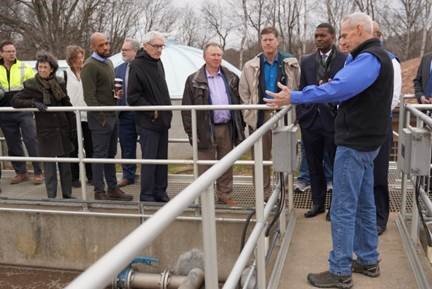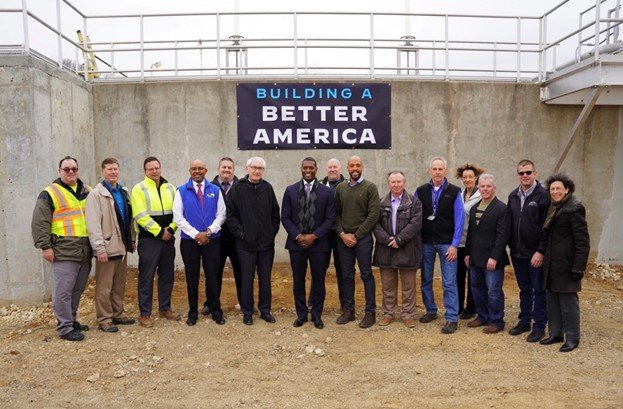
EPA Delivers on Three Water Commitments in the Agency's PFAS Strategic RoadmapWASHINGTON (April 28, 2022) – Today, the U.S. Environmental Protection Agency (EPA) is announcing three actions to protect communities and the environment from per- and polyfluoroalkyl substances (PFAS) in our nation's waters. The actions announced today advance progress under the Biden-Harris Administration's Plan to Combat PFAS Pollution by improving methods to detect PFAS in water, reducing PFAS discharges into our nation's waters, and protecting fish and aquatic ecosystems from PFAS. These efforts complement the historic investment of $10 billion to address PFAS and emerging contaminants secured under the Bipartisan Infrastructure Law.
A New Testing Method Will Help Detect PFAS in Water Robust, accurate methods for detecting and measuring PFAS in air, land, and water are essential for understanding which PFAS are in the environment and how much are present. Detection methods are also essential for evaluating the effectiveness of different technologies for remediating PFAS and for implementing future regulations. Today, EPA is publishing a new method that can broadly screen for the presence of PFAS in water at the part per billion level. EPA's new Screening Method for the Determination of Adsorbable Organic Fluorine (AOF) in Aqueous Matrices by Combustion Ion Chromatography (CIC) provides an aggregate measurement of chemical substances that contain carbon-fluorine bonds. PFAS are a common source of organofluorines in wastewater. This new method is especially useful for understanding the presence and forms of PFAS in wastewater when used in conjunction with methods that target individual PFAS. EPA's Draft Method 1621 has successfully completed single laboratory validation. Multi-laboratory validation will take place this summer and EPA intends to publish an updated version of the method later this year. New Permitting Direction Will help Reduce Discharges of PFAS to our Waters The National Pollutant Discharge Elimination System (NPDES) program interfaces with many pathways by which PFAS travel and are released into the environment and ultimately impact people and water quality. EPA is seeking to proactively use existing NPDES authorities to reduce discharges of PFAS at the source and obtain more comprehensive information through monitoring on sources of PFAS. Today, EPA issued a memo titled, Addressing PFAS Discharges in EPA-Issued NPDES Permits and Expectations Where EPA is the Pretreatment Control Authority. This memo provides instructions for monitoring provisions, analytical methods, the use of pollution prevention, and best management practices to address discharges of PFAS. These provisions will help reduce PFAS pollution in surface water as the agency aggressively embarks to promulgate effluent guidelines, multi-validated analytical methods, and water quality criteria recommendations that address PFAS compounds. EPA also plans to issue new guidance to state permitting authorities to address PFAS in NPDES permits in a future action. New Protective Levels Will Help Support Healthy Fish and Aquatic Ecosystems EPA is also developing national recommended ambient water quality criteria for PFAS to protect aquatic life. States and Tribes may use EPA-recommended water quality criteria to develop water quality standards that protect and restore waters, issue permits to address PFAS discharges, and assess the impact of PFAS pollution on local communities and the environment. EPA is proposing the first Clean Water Act aquatic life criteria for perfluorooctanoic acid (PFOA) and perfluorooctane sulfonic acid (PFOS)—two of the most well-studied chemicals in this group. The criteria are intended to protect aquatic life in the United States from short-term and long-term toxic effects of PFOA and PFOS. Following the comment period, EPA intends to issue final PFOA and PFOS recommended criteria, considering public comments and any new toxicity data. States and Tribes may consider adopting the final criteria into their water quality standards or can adopt other scientifically defensible criteria that are based on local or site-specific conditions. For more information on EPA's PFAS Strategic Roadmap, visit PFAS Strategic Roadmap: EPA's Commitments to Action 2021-2024 For more information on the Draft Method 1621, visit CWA Analytical Methods for Per- and Polyfluorinated Alkyl Substances (PFAS) For more information on the NPDES memo, visit: Industrial Wastewater For more information on aquatic life criteria for PFOA and PFOS, visit: Aquatic Life Criteria - Perfluorooctanoic Acid (PFOA) and Aquatic Life Criteria - Perfluorooctane Sulfonate (PFOS) Background The PFAS Roadmap sets timelines by which EPA plans to take specific actions and commits to bolder new policies to safeguard public health, protect the environment, and hold polluters accountable. The actions described in the PFAS Roadmap each represent important and meaningful steps to safeguard communities from PFAS contamination. Cumulatively, these actions will build upon one another and lead to more enduring and protective solutions. October 18, 2022, commemorates the first anniversary of the PFAS Strategic Roadmap and the 50th anniversary of the Clean Water Act. Passed in 1972, the Clean Water Act charted a new path for America's waters. Transformational progress has been achieved over the last 50 years. Waters that were once toxic and even caught fire, have been cleaned up. Significant challenges remain, including PFAS pollution, and EPA is committed to working toward a clean water future for all Americans. |
US EPA, Office of Public Engagement, 1200 Pennsylvania Avenue NW, Washington, DC 20460 United States



